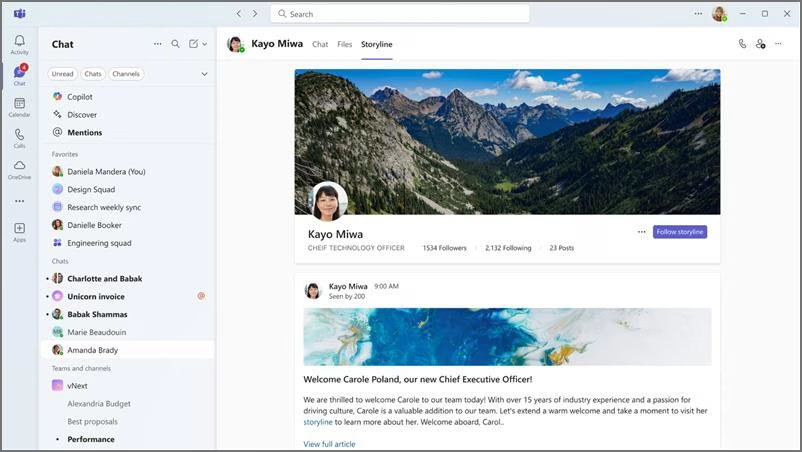Microsoft Teams Gets Social: Unpacking the Storyline Rollout
Remember when Microsoft Teams was primarily for scheduled meetings, quick chats, and file sharing? Well, it's been evolving, hasn't it? From integrating apps to offering more robust collaboration features, Teams has consistently tried to be the central hub for workplace productivity. And now, in a move that feels both inevitable and intriguing, Microsoft has started rolling out Storyline, a social media-style feed directly within Teams. This isn't just a minor update; it's a significant step towards making our digital workspaces feel a bit more, well, human.
What Exactly is Storyline and Why Does it Matter?
At its heart, Storyline is Microsoft's answer to the informal, dynamic communication we've grown accustomed to on platforms like LinkedIn, Instagram, or even Facebook. Think of it as a personal feed within Teams where you can share updates, celebrate successes, post quick video snippets, or even just share a thought-provoking article. It's designed to give employees a voice beyond the confines of a project channel or a direct message.
Why now, you ask? It's a bold move, and one that I think Microsoft has been eyeing for a while now. The shift to hybrid and remote work has highlighted a glaring gap in traditional collaboration tools: the loss of the "digital water cooler." Those spontaneous conversations, the quick updates shared in the hallway, the informal recognition – they're hard to replicate in a structured chat or meeting. Storyline aims to fill that void, fostering a sense of community and connection that often gets lost when we're not physically together. It's about making internal communication less formal, more engaging.
The Evolution of Social Features in Microsoft 365
This isn't Microsoft's first foray into integrating social media-like features into its enterprise offerings. We've seen the journey of Yammer, which eventually transitioned into Viva Engage. Viva Engage itself introduced a "stories" feature, much like what we see on consumer social platforms. So, Storyline in Teams isn't an isolated incident; it's part of a broader, consistent strategy.
Microsoft understands that people are comfortable with these formats in their personal lives. Why wouldn't they want similar ease and familiarity in their professional tools? By bringing a feed directly into Teams, where many of us spend a significant portion of our workday, they're reducing context switching and making it easier for users to engage. It's a smart play, really. They're meeting users where they already are, rather than forcing them to jump to another application.
Potential Impact and Practical Use Cases
The introduction of Storyline carries significant potential for enhancing user engagement and internal communication. Imagine a company-wide announcement that isn't just a dry email, but a short video from the CEO, followed by comments and reactions from employees. Or a team celebrating a project milestone with a quick photo collage. This kind of content is often more digestible and relatable than traditional text-based updates.
- Boosting Engagement: It could genuinely make Teams a more vibrant place. People might feel more connected to their colleagues and the company culture.
- Informal Knowledge Sharing: Quick tips, best practices, or even just interesting articles can be shared easily, fostering a more organic flow of information.
- Employee Recognition: A quick shout-out to a colleague for a job well done can be amplified through the feed, making recognition more visible and timely.
- Leadership Visibility: Leaders can share personal insights or quick updates, making them more approachable and transparent.
Of course, it's not without its challenges. The biggest one? Information overload. We're already drowning in notifications, aren't we? Ensuring Storyline doesn't just become another stream of noise will be critical. Companies will need to establish some best practices and encourage thoughtful use. It's a double-edged sword, this kind of feature, but the upside for connection is substantial.
Looking Ahead: Rollout and Future Implications
The news broke just a couple of hours ago that Storyline has started its rollout. This is exciting, but it's important to note the distinction: "rollout initiated" doesn't mean everyone has it today. Posts on X (formerly Twitter) from the tech community suggest that general availability for Storyline is anticipated in July 2025. So, while some users might see it popping up now, it'll likely be a phased approach before it's ubiquitous across all Teams tenants.
Conclusion
Microsoft Storyline in Teams is more than just a new feature; it's a statement about the evolving nature of workplace collaboration. It acknowledges that informal communication, community building, and personal expression are just as vital as structured meetings and project management. While the full impact remains to be seen as it rolls out globally, it's an interesting development, one that's been on the horizon for a bit now. It certainly signals Microsoft's continued commitment to creating more dynamic, engaging, and ultimately, more human digital workspaces.
